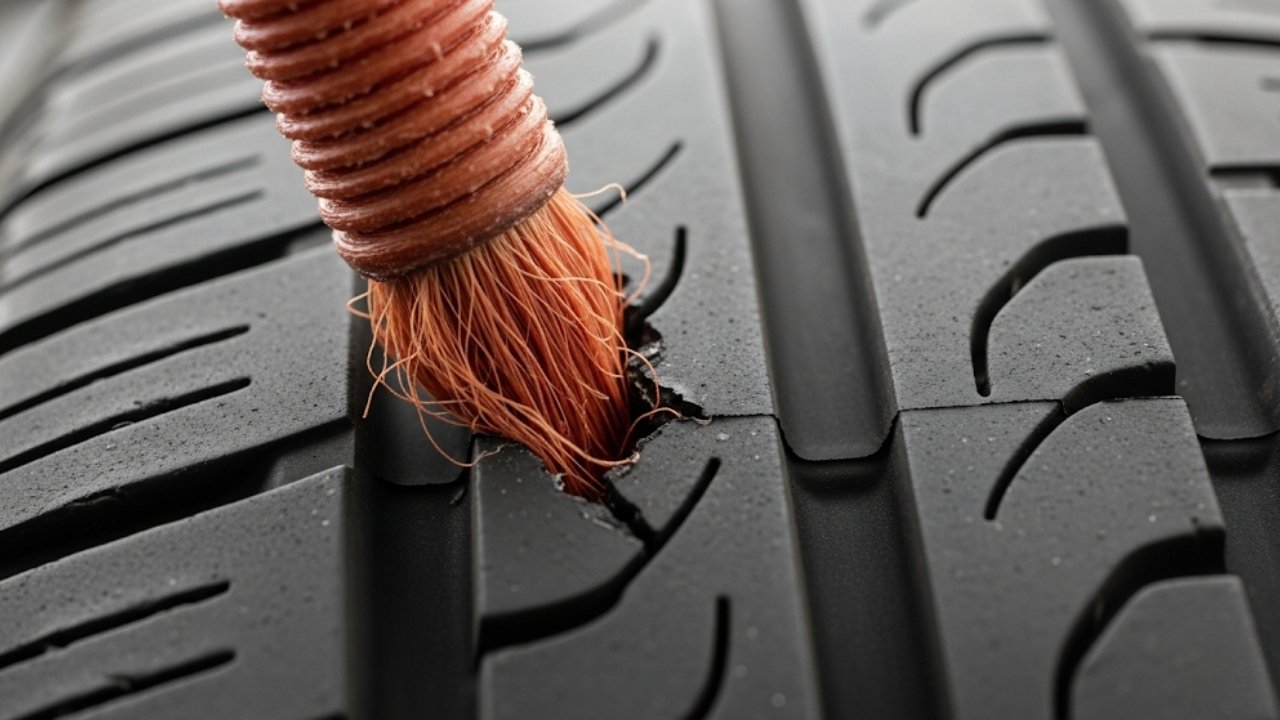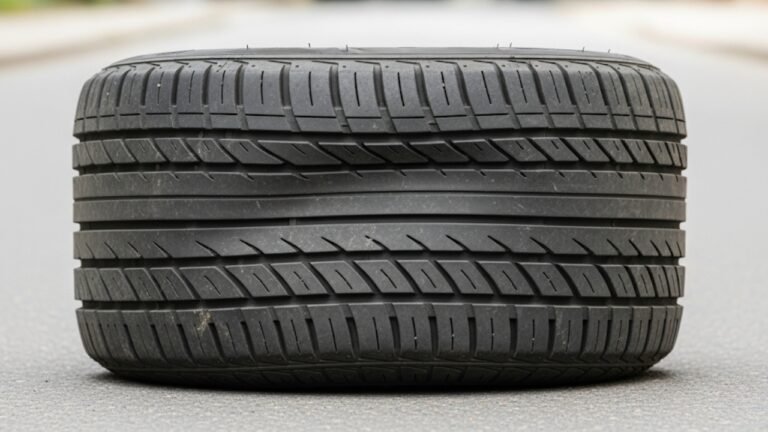How Long Can a Tire Plug Last?

We’ve all had that dreaded moment — you walk to your car, coffee in hand, ready to hit the road, only to find your tire sagging like a deflated balloon. Whether it’s a nail, screw, or some mysterious sharp object from the road, a puncture in your tire feels like a curse. And once you get it fixed with a tire plug, one question immediately comes to mind: how long can a tire plug last?
That’s the golden question — and not just for mechanics or car nerds. It matters to every driver out there who’s ever prayed their patch job holds up until payday. The truth is, tire plugs can last a long time, but it depends on how, where, and why the plug was installed.
In this article, we’re going to explore every angle — from personal experiences and mechanic insights to real-world stats and professional recommendations. I’ll tell you what’s worked for me, what hasn’t, and when to just toss the plug and get a new tire.
Let’s roll!
What Is a Tire Plug, Really?

Now, that plug doesn’t “heal” the tire. It just seals the hole — from the outside. Unlike patches that are applied from the inside, plugs are quicker, cheaper, and can even be DIY’d in a pinch.
But here’s the thing: plugs are designed for temporary repairs. However, many people — including myself — have driven for months or even years on a plugged tire. So, what gives?
The Average Lifespan: So, How Long Can a Tire Plug Last?
Let’s get straight to it — how long can a tire plug last?
-
Official recommendation: 7 to 10 years if properly installed on a safe puncture.
-
Real-world results: 1 to 40,000+ miles depending on conditions.
-
Temporary expectation: 8 to 12 months on average (especially for DIY jobs).
Bullet points of factors that impact plug lifespan:
-
Quality of plug material
-
Depth and angle of puncture
-
Location of the damage (center vs. sidewall)
-
Speed and heat exposure
-
Driving style (aggressive braking, off-road, etc.)
-
Proper installation technique
So yes, a plug can potentially last the life of the tire, especially when installed correctly. But that doesn’t always mean it should. It’s a bit like patching a hole in your favorite jeans. It might hold — for a while. But the more you wear them, the more likely they are to rip again.
Personal Story: My Plugged Tire That Refused to Die
Let me tell you about my 2016 Corolla. It picked up a screw on a country road just as I was heading to visit my aunt. I pulled over, cursing under my breath, and checked the trunk — no spare. But I had a plug kit and an old air pump.
With shaky hands and a YouTube tutorial running in the background, I plugged the tire, pumped it up, and prayed.
That tire? It lasted me another 14 months. Through city potholes, long highway drives, and even a trip to the beach. Not a single leak.
But — and this is important — it was a clean puncture near the center of the tread, and I checked it regularly. I got lucky.
Plug vs. Patch: Why the Type of Repair Matters
You might be wondering — why even use a tire plug when patches exist?
Let’s break it down in a simple comparison table:
| Feature | Tire Plug | Tire Patch | Plug-Patch Combo |
|---|---|---|---|
| Install Time | 5–10 minutes | 20–30 minutes | 30–45 minutes |
| Cost | $10–$20 (DIY) or $20–$40 (shop) | $25–$50 | $30–$70 |
| Durability | Moderate | Higher | Highest |
| Suitable For | Small tread punctures | Tread punctures only | Safer for bigger punctures |
| Not Recommended For | Sidewall or shoulder damage | Sidewall damage | Sidewall damage |
Tire plugs are fast and cheap but less secure. Patches, on the other hand, require dismounting the tire and sealing it from inside — better but slower. The safest option? Plug-patch combos used by professionals.
So if you’re wondering how long can a tire plug last, also ask: Is this the best repair for this kind of damage?
The Role of Puncture Location: It Matters More Than You Think
Here’s a big one: where the hole is.
-
Center of the tread? Great. That’s the safest place for a plug.
-
Near the sidewall? Nope. That’s a ticking time bomb.
-
Shoulder area (the curve between tread and sidewall)? That’s risky too.
Why? Because the sidewall flexes a lot. Every bump, turn, and twist puts pressure on it. A plug in that area just won’t hold for long — and it could blow out at high speed.
Pro tip: Never plug a tire on the sidewall. It’s not worth the risk. I once ignored that advice and had a plug pop out during a highway drive. Trust me — that thud-thud-thud sound in the middle of nowhere will shake your soul.
When Is It Safe to Drive on a Plugged Tire?
Let’s be real — not everyone can afford to replace a tire immediately. So driving on a plug is often a temporary solution that turns permanent.
It’s safe to drive on a plugged tire IF:
-
The puncture is less than ¼ inch wide
-
The hole is on the tread (not the sidewall)
-
The plug was installed correctly and snugly
-
There’s no visible bubbling or slow leak
-
You’re not racing or towing heavy loads
Unsafe scenarios?
-
You hear hissing
-
The tire keeps losing air
-
You notice vibration or wobbling
-
The plug was done in wet, dirty, or cold conditions
Even if you meet all the “safe” conditions, always check your tire pressure weekly and inspect the plug visually.
Can a Plug Be a Permanent Fix?
This is where the opinions split. Technically, no — according to the U.S. Tire Manufacturers Association (USTMA), a tire plug is not a permanent repair on its own.
But practically? Many folks, like me, have run tens of thousands of miles on a plugged tire. So the plug can be “permanent” — but with an asterisk.
To make it last, you’ve got to:
-
Avoid high speeds
-
Drive cautiously
-
Get it inspected by a pro within a few weeks
-
Consider replacing or patching if any issues arise
Remember, a plug doesn’t restore the tire — it just closes the wound.
Why Some Plugs Fail Sooner Than Others
Ever wonder why some people get 2 years out of a plug, and others don’t make it past 2 weeks?
Here are the usual suspects:
-
Cheap plugs: Not all rubber is made equal. Low-quality plug kits break down faster.
-
Bad install: If you didn’t ream the hole properly or the plug didn’t go in snug, it’ll leak.
-
Driving in extreme heat: High heat makes the plug expand, twist, or pop out.
-
Moisture: If water gets inside the tire, it can rust the steel belts and weaken the structure.
-
Aggressive driving: Burnouts, fast corners, hard braking? Not plug-friendly.
Think of it like duct-taping a leaky pipe. If you clean the pipe and wrap it right, it’ll hold. But do it in the rain with cheap tape, and it’s a mess.
Quick Recap: Key Takeaways So Far
Let’s summarize what we’ve covered in plain terms:
-
How long can a tire plug last? It can last days, months, or the full life of the tire — depending on how it’s done.
-
Plug = quick fix, not a magic solution.
-
Proper install, safe puncture location, and good driving habits all boost plug longevity.
-
When in doubt? Get it inspected or patched from inside.
Signs That Your Tire Plug Is Failing
Sometimes, the tire gives subtle hints that things aren’t okay — you just have to listen.
Watch out for these red flags:
-
Air loss over time: If your tire loses pressure every few days, the plug might not be sealing completely.
-
Hissing sound: A soft or faint hissing sound near the plugged area? That’s air escaping.
-
Visible bulges or cracks: Any abnormal lump near the plug could mean structural weakness.
-
Increased road noise: A whistling or thudding noise may be a sign the plug is loose or partially detached.
-
Rough or vibrating ride: That odd shimmy you feel on the highway? It could be your tire telling you it’s not okay.
Here’s what you should do if you notice any of these:
-
Pull over safely and inspect the plug area
-
Recheck the tire pressure with a gauge
-
If the plug looks worn or loose, visit a repair shop
-
Don’t try to patch it yourself again — too risky
Driving with a failing plug is like playing roulette with your tires. You might win a few miles… or lose a wheel.
Common Myths About Tire Plugs (And the Truths That Matter)
Let’s clear the air — tire plug myths are everywhere. And some can get you in trouble.
Myth #1: Tire plugs are permanent.
Truth: Only if done correctly, in the right location, and under ideal conditions.
Myth #2: You can plug any puncture.
Truth: Sidewalls, wide gashes, or shoulder damage should never be plugged. It’s unsafe.
Myth #3: Plugging a tire voids the warranty.
Truth: In some cases, yes — especially if the plug leads to further damage. Check your warranty terms.
Myth #4: It’s okay to plug the same tire multiple times.
Truth: Multiple plugs weaken the tire’s structure. More than two plugs? Time to replace the tire.
Myth #5: All plug kits are the same.
Truth: Cheap kits can fail quickly. Professional-grade plugs are more durable and better at sealing.
Just like using duct tape on plumbing, plugs can be handy — but only if you understand the risks.
How to Plug a Tire: Step-by-Step for DIY Heroes
Let’s say you’re stuck on the roadside with a slow leak. Here’s how to plug a tire safely:
What You’ll Need:
-
Plug kit (T-handle reamer, plug strips, insertion tool)
-
Tire sealant (optional)
-
Gloves
-
Air pump or inflator
-
Tire pressure gauge
Step-by-Step Instructions:
-
Find the leak.
Spray soapy water on the tire. Look for bubbles where the air is escaping. -
Remove the object.
Use pliers to pull out the nail or screw. -
Ream the hole.
Push the reaming tool into the hole and twist to clean and widen it slightly. -
Prepare the plug.
Thread a plug strip halfway through the eye of the insertion tool. -
Insert the plug.
Push the plug into the hole until about ½ inch sticks out. Then pull the tool out quickly. -
Trim the excess.
Use a blade to snip off any exposed plug material. -
Inflate the tire.
Pump the tire back to its normal PSI (check your car manual for the correct pressure). -
Check for leaks.
Spray soapy water again. If no bubbles — you’re good!
Pro Tip: Only plug the tire if the puncture is clean, small, and located on the tread. For anything more complicated, let a pro handle it.
Tire Plug Safety Tips You Shouldn’t Ignore
Whether you’re fixing it yourself or getting help, safety is always the top priority. Here are some essential safety tips:
-
Never plug a sidewall puncture
-
Don’t drive over 70 mph with a plugged tire
-
Avoid high temperatures and overinflating
-
Don’t plug a tire with internal damage or bulging
-
Inspect plugged tires monthly
-
Don’t mix plugging with patching unless a pro does it
Also, if you’re carrying passengers or planning a long trip, err on the side of caution. You don’t want a plug failure halfway up a mountain road with no signal.
Expert Opinions: What Do Mechanics and Tire Shops Say?
We’ve all heard different advice from different garages. Some mechanics swear by plugs. Others warn against them. So who’s right?
Here’s a balanced look:
| Professional | Opinion on Tire Plugs |
|---|---|
| Local Mechanics | Safe if done right, but should be checked |
| Big Chain Repair Shops | Prefer patch-plug combo for warranty and safety |
| Tire Manufacturers | Recommend internal patch or replacement |
| Insurance Experts | Don’t cover blowouts from improper plugs |
| Long-time Drivers | Mixed experiences – from 1 week to 5 years! |
In the end, it depends on your risk tolerance and how long you plan to drive on the plug. For peace of mind, a plug-patch combo is the safest bet.
FAQs: You Asked, We Answered
1. How long can a tire plug last in everyday driving?
If properly done, it can last 10,000 to 25,000 miles, or until the tire tread wears out.
2. Can I plug a tire myself?
Yes, but only for small tread punctures, and follow instructions carefully. Improper repairs can lead to dangerous blowouts.
3. Is a plug better than a patch?
Not really. Patches are more secure because they seal from the inside. Plugs are faster but less durable.
4. Can I drive on the highway with a plugged tire?
You can — but not at high speeds. If the plug was done right and the tire holds pressure, short highway trips are okay.
5. How do I know if the plug is holding?
Check tire pressure every few days. If it stays consistent, the plug is working. Also, inspect visually for leaks.
6. Are tire plugs legal?
Yes, they are legal in most places — but they may void some warranties and fail inspection in others.
7. How many times can I plug a single tire?
Once or twice, max. More than that, and it’s not safe. Replace the tire.
8. Do plug kits work in rainy weather?
Not really. Wet or dirty holes won’t hold the plug well. Do it in dry conditions or visit a shop.
Final Thoughts: Plugged, Patched, or Replaced?
At the end of the day, you’ve got to decide what’s best for your safety and your wallet.
If you’re asking how long can a tire plug last, the short answer is: a long time — or not long at all. It all comes down to:
-
The quality of the plug
-
Where the damage occurred
-
Who did the plugging
-
How you drive afterward
From my own experience and countless chats with mechanics, a properly plugged tire can safely last thousands of miles — even the rest of the tire’s life. But it’s a gamble if you skip steps or plug the wrong type of damage.
So be smart. Be cautious. And when in doubt — call a professional.
Because sometimes, a $40 tire repair beats a $400 tow any day.



